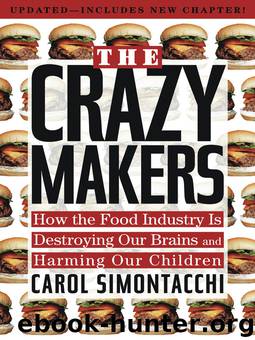The Crazy Makers by Carol Simontacchi

Author:Carol Simontacchi
Language: eng
Format: epub
Publisher: Penguin Publishing Group
Published: 2010-03-01T05:00:00+00:00
CRAZY MAKER
AWARD
TEENAGE DIVISION/ SECOND PLACE :
The entire teen food culture, including the fast-food chains and the soft drink marketers. For encouraging poor nutritional habits by expensive advertising campaigns that entice teenagers into eating nonfoods that destroy their brains.
The problem of junk food in the schools is gaining national attention, fortunately. Many states have started pulling vending machines and other sources of non-nutritious snacks out of schools, or replacing the worst items with fresh fruit and bottled water. In 2007, the Center for Science in the Public Interest (CSPI) issued a press release that discusses the fund-raising aspect of junk foods. Not surrprisingly, the CSPI recommended ending candy, cookie, doughnut, and pizza sales, and even bake sales, and removing vending machines. “Time-strapped parents typically purchase low-nutrition baked goods for the sales, only to send their children to school with money to buy them back. Parents end up paying twice.”15
What is surprising is how little money these efforts produce for schools. Campbell’s and General Mills each sponsor label-redemption programs that sound good but in fact require parents to purchase 27,850 cans of Campbell’s soup (about $33,000 worth) to earn a single $300 digital camcorder. Beverage contracts with soft-drink companies usually raise less than one-quarter of 1 percent of a school district’s budget, an amount that can easily be substituted by more healthful options.
The CSPI recommends physical-activity fund-raisers such as walkathons, or book fairs, recycling events, healthful-food sales, and other projects that encourage good nutrition, fitness, and active participation—all positives for the kids.
When your kids leave the school building each day and walk home, they are bombarded with another segment of the food culture that contributes to their deteriorating mood and cognition—fast-food chains.
Our teens are eating the worst possible foods, starting with breakfast and continuing on throughout the day. While some studies seem to indicate that breakfast contributes a significant share of nutrition, other studies disagree. According to a study published in the American Journal of Clinical Nutrition, breakfast consumption is declining, particularly in older adolescents age fifteen to eighteen.16 What concerns me as much, however, is that when kids do eat breakfast, it is primarily empty calories.
American teenagers are poorly nourished in most minerals, primarily calcium, iron, zinc, copper, and magnesium, and many vitamins, including B12, vitamin D, folic acid, and others—all of which play a critical role in brain health.17
While other studies show that supplies of sodium, potassium, phosphorus, and others are adequate, I’m baffled.18 From where are they possibly getting the potassium? Potassium is found primarily in vegetables and fruits—they don’t eat vegetables and fruit. I’m sure they get enough sodium—too much sodium. Sodium is liberally added to highly processed foods, of which they get too much.
Download
This site does not store any files on its server. We only index and link to content provided by other sites. Please contact the content providers to delete copyright contents if any and email us, we'll remove relevant links or contents immediately.
Nutrition for Sport, Exercise, and Health by Spano Marie & Kruskall Laura & Thomas D. Travis(3692)
Nutrition for Sport, Exercise, and Health by Marie Spano & Laura Kruskall & D. Travis Thomas(3664)
The Sprouting Book by Ann Wigmore(3527)
Flavor Flours by Alice Medrich(2778)
Superfood Smoothie Bowls: Delicious, Satisfying, Protein-Packed Blends that Boost Energy and Burn Fat by Chace Daniella(2363)
Memory Rescue by Daniel G. Amen(2355)
Dirty Genes by Ben Lynch(2255)
The Bad Food Bible by Aaron Carroll(2214)
Genius Foods by Max Lugavere(2089)
The Poisoner's Handbook by Deborah Blum(2075)
Good Calories, Bad Calories by Gary Taubes(2051)
The Main Street Vegan Academy Cookbook by Victoria Moran(2018)
The I Quit Sugar Cookbook by Sarah Wilson(1979)
Core Performance Essentials by Mark Verstegen(1963)
Memory Rescue: Supercharge Your Brain, Reverse Memory Loss, and Remember What Matters Most by Amen Dr. Daniel G(1930)
Big Girls Do It Stronger by Jasinda Wilder(1876)
Android App Development by Franceschi Hervé J.;(1808)
Sugar Crush by Dr. Richard Jacoby(1757)
Dr. Colbert's Keto Zone Diet by Don Colbert(1615)
